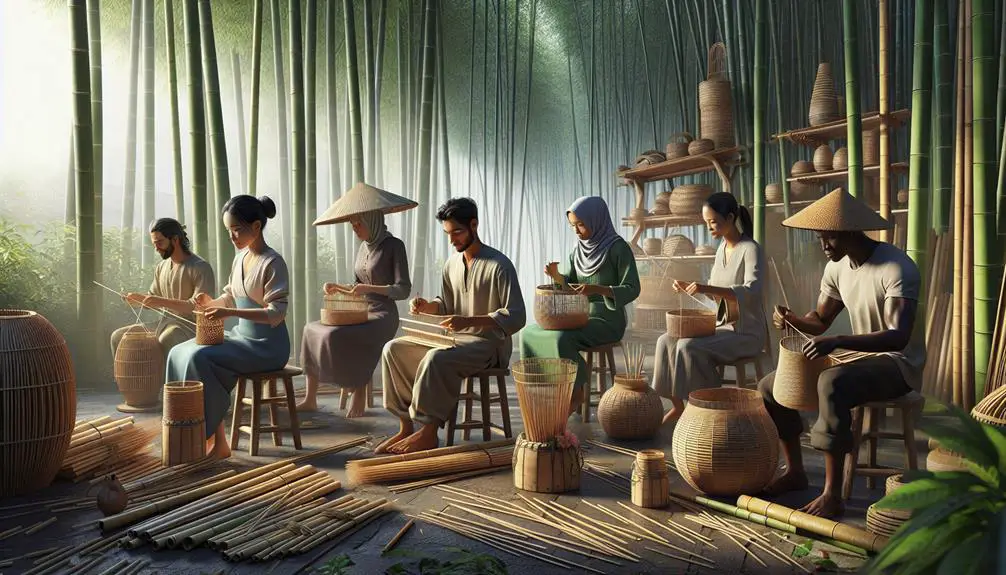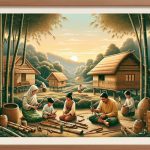Bamboo crafts are a big deal in the Philippines. They're not just cool items for tourists; they're part of our heritage and create stable jobs for lots of local artisans. These crafts, like the unique bamboo fans from Ilocos Sur, showcase the incredible skill and culture of different Philippine regions. Plus, bamboo is amazing for the environment – it grows super fast, helps absorb carbon dioxide, and protects our soil. Every bamboo piece tells a story, blending past with present and keeping our traditions alive. And there's a lot to find out about how this craft shapes our country's culture and economy.
Table of Contents
Key Takeaways
- Bamboo crafts provide stable income and livelihoods for local artisans in the Philippines.
- They play a significant role in preserving Filipino cultural heritage and traditional skills.
- Bamboo's rapid growth and environmental benefits contribute to carbon absorption and soil stabilization.
- Technological innovations in crafting enhance the efficiency and quality of bamboo products.
- Filipino bamboo crafts have strong export potential and global market presence.
Historical Significance of Bamboo Crafts
Bamboo crafts have been a big part of Filipino culture since way back before the Spanish arrived, used for everything from building homes to crafting boats. It's not just about utility though; these crafts are a deep-seated part of our cultural heritage. I mean, take the 'lakub' from some provinces. This isn't just any old basket; it's a work of art that involves a meticulous process from the careful cutting of bamboo to its detailed decoration. It really shows off the skills of Filipino craftsmen.
In places like Ilocos Sur, bamboo fans are crafted traditionally and are super popular even today. Then there's Rizal and Nueva Ecija, where they make these festive arches that are just stunning. These aren't just crafts; they're a celebration of our history and culture.
What's really cool is seeing institutions like the National Commission of Culture and the Arts stepping up to keep these traditions alive. They're all about reviving and preserving these unique bamboo crafts that highlight our Filipino craftsmanship. It's not just about keeping old traditions; it's about honoring our identity and showing the world what we're made of.
Economic Impact on Local Communities
Local communities really thrive economically thanks to the crafting and sale of bamboo products. The beauty of bamboo crafts isn't just in the art but also in the significant boost they give to the local economy. Imagine this: every bamboo stool, basket, or decorative piece sold puts money right back into the local artisan's pocket. It's a win-win; they get to preserve their cultural heritage and make a living.
Here's a cool way to look at it:
| Aspect | Impact |
|---|---|
| Livelihood Opportunities | Local artisans gain stable income |
| Economic Growth | Boosts local economies |
| Cultural Preservation | Keeps traditional skills alive |
Environmental Benefits of Bamboo
I've learned that the giant bamboo not only beautifies our landscapes but also plays a crucial role in protecting our environment. In the Philippines, the environmental benefits of bamboo are seriously impressive.
For starters, those deep roots of bamboo help a lot. They grab onto the soil and make sure it doesn't just wash away with rain or flood. This means less soil erosion and more stable riverbanks. It's like bamboo is the quiet hero holding the ground together.
Then there's the speed at which bamboo grows—it's mind-blowing! We're talking up to 10 centimeters a day. This rapid growth isn't just cool to watch; it also means bamboo absorbs carbon dioxide quickly, which is great for cleaning up the air we breathe. Plus, it releases more oxygen than the typical trees do. More oxygen in the air? Yes, please!
And let's not forget about the leaves. During heavy rains, bamboo foliage acts like an umbrella for the soil. It catches the raindrops, reducing their impact and helping to prevent the soil from getting stripped away. This natural shield plays a vital role, especially during the stormy seasons here in the Philippines.
Cultural Heritage and Artistry
Delving into the world of Filipino bamboo crafts, we uncover a rich tapestry of cultural heritage and artistic mastery. It's not just about making stuff; it's about keeping a legacy alive, a tale told through each weave and carve. Walking through the villages, the click and clatter of bamboo being shaped, it's like a melody, rooted deep in the Filipino soul.
Bamboo crafts aren't just objects; they are a bridge to the past. The 'lakub', for example, isn't merely a decorative piece but a symbol of identity for the Maranao people of Mindanao. I've seen how these crafts are more than just art; they are the heartbeats of cultural pride and skills passed through generations.
Efforts to revive these traditions highlight a renaissance of Filipino craftsmanship, acknowledging that bamboo crafts are priceless. Here's a quick look at how deep these roots go:
| Craft | Region | Significance |
|---|---|---|
| Lakub | Mindanao | Cultural Identity |
| Fans | Various | Artistic Expression |
| Festive Arches | Provinces | Community Celebrations |
| Bamboo Weaving | Nationwide | Heritage Skill |
| Decorative Art | Local Areas | Traditional Techniques |
Each piece tells a story, a whisper of the past, crafted into the present, urging us to appreciate and preserve.
Types of Bamboo Crafts Produced
In the Philippines, we see a variety of bamboo crafts, including fans, festive arches, and the vibrant 'lakub' containers. Each of these traditional items tells a unique story of the regions and the people who make them. Let me walk you through some fascinating details!
Fans are especially popular in Ilocos Sur. They're not just practical for beating the heat but also serve as charming souvenirs. The craftsmanship involved is quite meticulous, focusing on creating a durable yet elegant product.
Moving on, festive arches are a big deal in places like Rizal and Nueva Ecija. These aren't just any decorations; they're crafted for celebrations, making any event feel extra special. The attention to detail in intertwining bamboo strips to form these arches is simply mesmerizing.
Now, let's talk about the 'lakub'. This craft is close to the heart of the Maranao people of Mindanao. It's not just a container; it's a piece of art, adorned with colorful paper and cloth, showcasing vibrant, multi-hued designs. The process of making 'lakub' is quite intensive, involving cutting, drying, and even boiling bamboo to achieve the right texture and durability.
These bamboo crafts are more than just items; they're a testament to the rich cultural tapestry of the Philippines.
Challenges in the Bamboo Craft Industry
As we look at the bamboo craft industry in the Philippines, it's clear we're facing some tough challenges.
We're dealing with issues like not having enough skilled workers, finding it hard to get our products to bigger markets, and making sure we've enough bamboo to keep going.
It's a bit of a struggle, but we're working on it.
Resource Sustainability Issues
The bamboo craft industry in the Philippines is up against some tough challenges, especially when it comes to keeping things sustainable. We're seeing a real push for bamboo sustainability, but it's not easy without enough government support or modern tech. The good news? There's a growing effort to use technology better and adopt best practices that could really turn things around.
| Challenge | Current Efforts |
|---|---|
| Technology Adoption | Integrating modern equipment |
| Government Support | Seeking increased involvement |
| Bamboo Sustainability | Promoting eco-friendly practices |
| Quality Improvement | Implementing best practices |
It's all about innovation and getting the right support to make our bamboo crafts not just beautiful, but sustainable too.
Skilled Labor Shortage
Moving beyond sustainability challenges, another big hurdle for the bamboo craft industry is the shortage of skilled labor. It's tough out there—fewer folks are into making traditional crafts, and it's hitting bamboo crafts hard. The young ones aren't really picking up the skills, which makes it super tricky to keep these traditions alive. We're seeing fewer skilled artisans around, and honestly, it's a bit worrying if we think about the future of bamboo crafts here.
We gotta figure out how to get more people interested and trained up. If we don't, we might lose a big part of our cultural heritage. It's about keeping these skills and traditions going strong, right? Let's not let them slip away.
Market Access Limitations
Facing another major challenge, limited market access really holds back the bamboo craft industry in the Philippines. It's tough 'cause lots of talented folks here make amazing bamboo crafts, but they just can't get them out to more people, especially beyond our local spots.
We're talking about needing better ways to show off these crafts on bigger stages, like international markets, you know? Right now, we're missing out 'cause the channels to push these products globally aren't quite there. It's a big deal to crack into those markets, and without that, we're kinda stuck playing small.
Getting past this roadblock is key if we want our bamboo craft scene to really fly high.
Technological Innovations in Craftsmanship
Bamboo craftsmanship's really stepping up its game with some cool tech. We're seeing a big shift with the integration of modern tools and digital design software. It's not just about traditional techniques anymore; it's about making those techniques fly with some high-tech help.
Here's what's getting everyone excited:
- Laser Cutting and 3D Printing: These aren't just buzzwords. They're revolutionizing how intricate patterns are etched into bamboo, making every piece both precise and unique.
- Digital Design Software: This allows for the creation of complex designs that were once impossible. Imagine translating the swirls of your imagination directly onto bamboo, all without losing the traditional touch.
- Automation and Robotics: These are slowly taking over the grunt work. It means less sweat and more creativity for the craftsmen, pushing the boundaries of what bamboo can become.
This meld of old-school crafting with next-gen tech not only boosts efficiency but also elevates the quality to new heights. It's a game changer, making sure that bamboo isn't just seen as a simple material but as a canvas for both artistic expression and technological innovation. So, yeah, bamboo craftsmanship's definitely not stuck in the past!
Global Influence and Export Potential
The Philippines is making big waves in the global market with its unique and sustainable bamboo crafts. As I've seen, these products aren't just beautiful; they're a testament to the skill and heritage of Filipino craftsmen. These artisans churn out everything from snazzy household items to eye-catching decorative pieces, all made from bamboo. It's no surprise that there's a growing global demand for these eco-friendly and culturally rich items.
I've learned that the best places to witness the richness of this craft are local markets and international trade shows where Filipino bamboo crafts stand out. Their global influence isn't just about filling up homes with pretty things; it's about sharing a piece of Filipino culture with the world.
And hey, if you're keen on exploring more about these crafts or maybe even buying a few, don't forget to save my website in this browser. You'll find loads of info and stories about these amazing creations that travel from our islands to homes worldwide. It's clear that the export potential of these bamboo crafts is huge, pushing the Philippines further onto the global stage. What a fantastic way to showcase sustainable artistry!
Frequently Asked Questions
What Is the Significance of Bamboo in Philippines?
Bamboo's really big in the Philippines, not just for crafts but culturally too. It pops up in our myths and daily life, and there's a whole art to making things from it.
What Is the Significance of Using Bamboo as Craft?
I've learned that using bamboo for crafts is really significant. It's not just eco-friendly; it also supports local traditions and provides income, keeping cultural heritage alive and kicking in many communities.
What Is the Cultural Significance of Bamboo Weaving?
Bamboo weaving's not just craft; it's a rich cultural expression. Through intricate designs and natural dyes, it showcases indigenous artistry and deep-rooted traditions, especially in celebrations like weddings or births.
What Is the Bamboo Art Capital of the Philippines?
I've learned that Abra is known as the Bamboo Art Capital of the Philippines. They're famous for their intricate bamboo crafts, showcasing the Tingguians' rich culture and exceptional craftsmanship in bamboo art.
- The Use of Nonwovens in Construction and Civil Engineering - July 11, 2025
- The Use of Nonwovens in Construction and Civil Engineering - July 11, 2025
- The Use of Nonwovens in Construction and Civil Engineering - July 11, 2025






